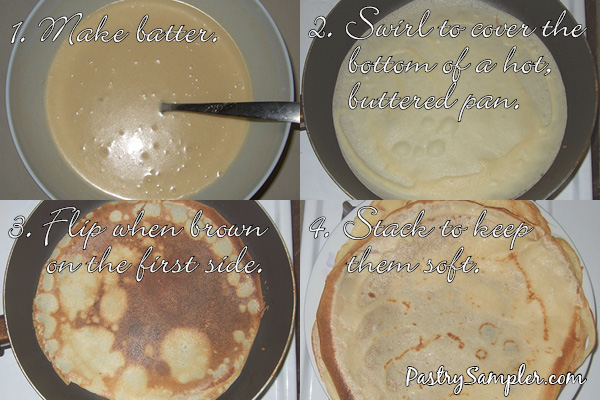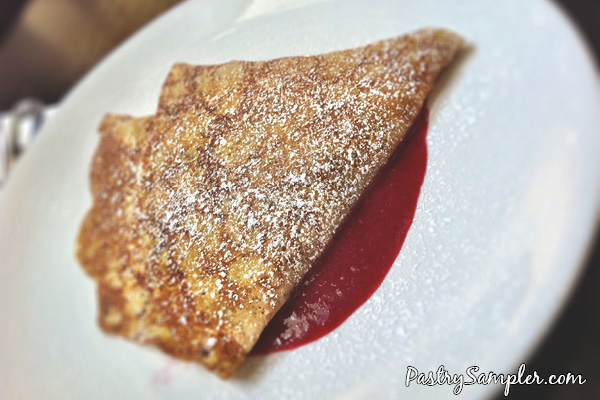All About Crêpes - Recipes, Tips and More
By Renee
Shelton


I
love crêpes. Not only are they delicious, but are extremely versatile: sweet or savory, plain or filled. And very easy to prepare. Crepe batters can also be made ahead of time for busy days when you want them fresh, or you can prepare a stack of crepes ahead of time and frozen for later.
The
types of flour used in crêpes really depends on what types of
crêpes you'll be making. Typically, all-purpose
flour is used but specialty flours bring different flavor profiles to the finished crepes, especially when a filling is used or when a spice is used inside the batter.
There
is no leavening in crêpes; no baking powder or soda is added
to the batter like regular pancake batters to help them fluff up. Crepes are meant to be flat and paper thin which is their hallmark. Most recipes call for the crêpe batter to rest before cooking which helps to relax
the gluten, and to release any air bubbles that may have formed in whisking or blending. This resting
time also gives the flour a chance to expand and absorb the liquids in the batter, and can also intensify flavors a touch. In Paul Bocuse's French
Cooking, he suggests there is a slight fermentation that goes on when resting the batter in a warm area:
It
is important to prepare [the] batter at least 2 hours before using
it; keep it in a warm place to produce an almost imperceptible fermentation.
Besides the advantages to the crepes themselves, there is an advantage
to resting the batter simply for mise en place—one more thing you can prepare in advance
in the kitchen to save time. But while the school of thought is to always
rest the batter, I have made crêpes
successfully without resting the batter when pressed for time. Crepes are beautiful for their simplicity.
My Crêpe Cooking Tips - From Mixing to Serving
- After
mixing, if you notice lumps don't fret: simply strain. I usually strain
my crêpe batter in any case because it seems to help get rid
of any air bubbles that may have formed in the batter. But it isn't
necessary and most recipes do not call for straining.
- If, after resting,
the batter changes consistency and thickens, simply add a touch more
liquid. The optimal consistency is have the batter run like cream.
- When pouring
the batter into the pan, make sure the pan is hot (or you may have
to scrape the bottom to get the crêpe
out), and well oiled. The first one or two made will probably soak up any excess fats
used for greasing the pan.
- Do
not pour too much batter into the pan you're using. The key
for crêpes is to think thin, and if too much is added you risk the chance of
having a very heavy, flat pancake. The simple way to know how much
to use is to just do a sample run: place desired amount of batter
onto prepared pan's surface and quickly swirl the pan to get the batter
even. If it's too thick, use less the next time and if doesn't coat the surface,
use a little more.
- After
finishing a crêpe, place on a towel-covered plate. When making
crêpes for sweet applications, you can sprinkle each crêpe very lightly with granulated sugar before stacking another fresh
one on top to keep them separated. Any crêpe when being made, should be stacked one
on top of the other as they are being made, and you really shouldn't have
any problems with them sticking to one another. Stacking the crepes helps keep them
soft and fresh and prevents them from drying when used for filling and rolling.
- Crêpes
can easily be refrigerated or frozen for advanced prep.
- When
making them, you will have an obvious 'presentation' side: the side
that was cooked first. If folding or rolling use that side for the
outside as it is the most attractive.
The
last thing to know about crêpes is that they are not just for pro chefs. And you should have fun making them.
While they may intimidate a novice, don't be tempted to purchase frozen crêpes. Your guests will definitely give thanks for the
extra time in cooking them - for fresh made crêpes will always taste
better than manufactured, whether or not they are perfect in shape.

Storing Crêpes
From the Egg Farmers of Alberta, here are some tips for storing crêpes after cooking, if you will be making them ahead of time.
- Refrigerator: For storing them up to 3 days - stack them up and wrap well in plastic wrap. Let stand at room temperature for about an hour before using them.
- Freezer: For storing them up to 4 months - separate them with wax paper and seal them up in a large storage container. Once they are frozen, the tend to break easily, so handle with care. Let them thaw completely before unwrapping and separating them.

Crêpe Recipes
Note: All recipes contain just the procedure for the batters. They are made in the same way: heat a crêpe pan, add oil or butter to coat. Add in the batter and swirl to cover the bottom. Cook until the crêpe is lightly brown on the first side, about a minute. It will loosen when it is ready. Turn it over and finish cooking, about 30 seconds or so more. Stack them up as you finish the others. The presentation side for all crêpes will be the first side you cook (always the 'browner' side), and the filling side will be the opposite side.
Crêpes
Ménagères (Crêpes home style)
Adapted
from Paul Bocuse's French Cooking (my husband's signed copy, thanks
Mr. Bocuse!). A basic dessert recipe.
2 1/2 cups sifted
flour
Pinch of salt
1/2 cup sugar
3 eggs
1 1/2 cups boiled milk, cooled
Flavoring, such as dash of orange-blossom water, rum, kirsch or other
desired liqueur
Mix the dry ingredients
in a bowl. Add the eggs, mixing each well into the batter before adding
another. Add in the milk in small quantities while beating. Let the
batter rest at least 2 hours. Finish by adding a flavoring just before
using.
_________________________
Basic
Crêpes (Savory)
This
is adapted from Craig Claiborne's New York Times Cook Book, and can
be used in a variety of savory applications. His recipe calls for straining
the batter, and doesn't call for letting the batter rest before using
it.
1
egg
1/2 cup flour
Pinch of salt
1/2 cup plus 2 tablespoons milk
2 tablespoons butter, separated
Put
egg, flour and salt in bowl and beat with whisk, adding in the milk.
Melt 1 tablespoon of the butter in a non-stick pan (or your desired crêpe
pan) and pour the melted butter into the mixed crêpe batter. Mix
well. Pour the finished batter into a sieve over a mixing bowl, and
press on any solids with a rubber spatula. Melt the remaking butter
separately and use to brush the surface of the pan as necessary when
cooking them.
_________________________
Crêpes
This
recipe uses bread and cake flour, and is an industry recipe. This will
make a little over 4 lbs. of batter: enough for about 50 crêpes.
This is adapted from Professional Baking.
8
oz. bread flour
8 oz. cake flour
2 oz. sugar
.5 oz. salt
12 oz. eggs
2 lbs. milk
5 oz. clarified butter
Sift flours, sugar,
and salt into bowl. Add eggs and just enough of the milk to make a soft
paste with the flour; mix well until smooth and lump free. Gradually
stream in the rest of the milk and the clarified butter. If there's
lumps, strain it. It it's too thick add a little water. Let rest 2 hours
before using.
_________________________
Daniel
Pinaudier's Crêpes
This
recipe comes from The Roux Brothers on Patisserie, and uses cream in
the batter. The suggested flavorings include vanilla, orange blossom
water, lemon zest or Grand Marnier, or they can just be mixed up and
cooked plain.
2 1/4 cups flour
2 tablespoons sugar
Pinch of salt
4 eggs
2 1/4 cups milk, boiled and cooled
7/8 cups heavy cream
Desired Flavoring
Mix dry ingredients in a bowl, and add the eggs, 2 at a time, mixing
well. Stir in 1/3 of the milk until you have a smooth, homogenous batter,
then add in the cream and the rest of the milk. Leave to rest in a cool
place at least 1 hour before using the batter. When ready to use, stir
in the chosen flavoring, and use clarified butter for the oiling of
the pan.
_________________________
Here are two
recipes from old clippings of a newspaper, the food section "FoodDay"
of The Oregonian. Both recipes come from Madeleine Kamman,
dates unknown.
Basic
Dessert Crêpe Batter
| 3/4
cup flour, sifted |
2
egg yolks |
| 1/4
teaspoon salt |
1
cup milk, less 2 tablespoons |
| 1
tablespoon powdered sugar |
4
tablespoons melted butter |
| 2
eggs |
2
tablespoons liqueur of choice |
Put the dry ingredients
in bowl. Make a well in center, and add eggs and yolks and mix until
the mixture is shiny; do not whip the batter too much. Add the milk
gradually, and then the butter and liqueur. The result should be a texture
lighter than heavy cream, and should be strained to remove any lumps.
Let the batter stand for about 15 minutes before using. Stir batter
before making each crêpe. Leftover batter can be stored in refrigerator
for a day.
Basic
Savory Crêpe Batter
| 3/4
cup flour, sifted |
1
cup milk |
| 1/2
teaspoon salt |
4
tablespoons melted butter |
| 3
eggs |
|
|
|
Put the dry ingredients
in bowl. Make a well in center, and add eggs and mix until the mixture
is shiny; do not whip the batter too much. Add the milk gradually, then
the butter. The result should be a texture lighter than heavy cream,
and should be strained to remove any lumps. Let the batter stand for
about 15 minutes before using. Stir batter before making each crêpe.
Leftover batter can be stored in refrigerator for a day.
_________________________
All-Purpose Crêpes
Go sweet or savory with these. Adapted from the Egg Farms of Alberta, this simple recipe creates thin crêpes that are sturdy enough for any filling. This uses a blender method for mixing.
2 cups all-purpose flour
1 teaspoon salt
2 cups milk
4 eggs
1/4 cup melted butter
Add all the ingredients to the blender. Attach the cover, and blend for about a minute to incorporate ingredients. Scrape down sides and bottom, and blend again until smooth, about 15 to 30 seconds more. Let the batter rest in the refrigerator for at least an hour. Check the consistency before using, and add in additional liquid to thin it down if necessary.
_________________________
Crêpes with Amaranth Flour
This
uses amaranth flour and soy milk for a great flavor. Substitute the eggs and butter with vegan alternatives to make them vegan. It is adapted from Arrowhead Mills, Inc. via Recipe Source.
3 eggs
1 teaspoon honey
1 teaspoon vanilla extract
2 tablespoons butter, melted
3/4 cup soy milk
1/3 cup amaranth flour
1/8 teaspoon sea salt
Add the eggs to a blender and mix to beat. Add in the rest of the liquid ingredients, and then the dry ingredients. Blend until smooth.
_________________________
Chocolate Crêpes
These crêpes have cocoa powder in the batter, and are flavored with a little almond extract. This adapted recipe is via Recipe Source.
1/2 cup all-purpose flour
1 tablespoon cocoa powder (sifted if lumpy)
2 teaspoons sugar
Pinch of salt
3/4 cup milk
1/4 teaspoon almond extract
1 egg, beaten
2 teaspoons butter, melted
Mix the dry ingredients together in a bowl. Add in the milk and almond extract, and beat until smooth. Add in the egg, and stir in the melted butter. Refrigerate the batter for 2 hours before using.
_________________________
Buckwheat Crêpes
These crêpes use white flour and buckwheat flour. This adapted recipe is via Recipe Source. Note: While this recipe is great for making ahead of time, after resting check the texture of the batter. It should be no thicker than cream, and if the buckwheat has thickened the batter considerably after resting, add in additional liquid to thin it back down.
1 cup water
1 cup milk
3 eggs
2/3 cup all-purpose flour
1/2 cup buckwheat flour
1/2 teaspoon salt
3 tablespoons butter, melted
Add all the ingredients to a blender. Cover the top, and blend briefly incorporate the ingredients. Scrape down the sides and the bottom if any dry ingredients are stuck there, and then blend again just until the ingredients are blended and smooth. Pour the mixture into a mixing bowl, and cover. Let rest for about an hour before using.
_________________________
Mustard Seed Farina Crêpes
Farina is what Cream of Wheat (the breakfast hot cereal) is. I have found this recipe a perfect accompaniment to serve leftover vegetarian Indian food: heat filling, wrap up in fresh crepes, and serve with a favorite spicy chutney, pickle, or raita. This adapted recipe is via Recipe Source, credited to Yamuna's Table cookbook by Yamuna Devi, and differs from all the other recipes on this page in that it contains a very small amount of baking powder.
2/3 cup farina (quick cooking Cream of Wheat)
2/3 cup all-purpose flour
2 cups water, plus more as needed
1 tablespoon olive oil
1/2 teaspoon mustard seed
1/2 teaspoon salt
1/8 teaspoon baking powder
Mix the flour and Cream of Wheat together in a mixing bowl. Add in the olive oil and 2 cups of the water. Whisk until smooth. Let the batter rest while you are preparing the mustard seeds. Heat the mustard seeds in a small frying pan set over medium high heat. Swirl the pan and heat until the mustard seeds begin to pop. Remove them from heat and add to the batter. Add in the salt and baking powder, and then whisk everything until smooth. Check the batter consistency, and if too thick, add in additional water to loosen it.
_________________________
Blue Cornmeal Crêpes
These crêpes call for blue cornmeal which give a great look and flavor to meals using Southwestern-style fillings. This adapted recipe is via Recipe Source.
1/4 cup all-purpose flour
1/4 cup blue cornmeal
1 teaspoon salt
4 eggs
1 cup milk
2 oz. clarified butter
Stir the dry ingredients together, and add in the wet ingredients. Whisk until smooth. Let stand for about 30 minutes before using. Check the consistency before making the crêpes, and add in additional liquid if it becomes too thick after resting.
Images:
Image of crepes with blueberry sauce courtesy Wikimedia Commons via CC License; Images of four crepes in picture-graphic story courtesy Wikimedia Commons via CC License; Image of folded crepe on plate courtesy Flickr, user ultrakml via CC License.
References
used:
Bocuse,
Paul. Paul Bocuse's French Cooking. New York: Pantheon, 1977.
Claiborne,
Craig. The New York Times Cook Book. Revised Ed. New York: Harper,
1990.
Gisslen,
Wayne. Professional Baking. New York: John Wiley, 1985.
Roux,
Michel and Albert. The Roux Brothers on Patisserie: Pastries and
Desserts from 3-Star Master Chefs. New York: Prentice, 1986.
"Crêpes." Alberta Egg Producers.
Site accessed 4 October, 2014.
Recipe Source.
Online search results for crepes. Site accessed 31 May, 2006, and 4 October, 2014.
Recipes from Madeleine Kamman
clipped and adapted from The Oregonian "FoodDay," no
date, recipe noted from The Making of a Cook by Madeleine Kamman.
Renee Sheltonon

|














